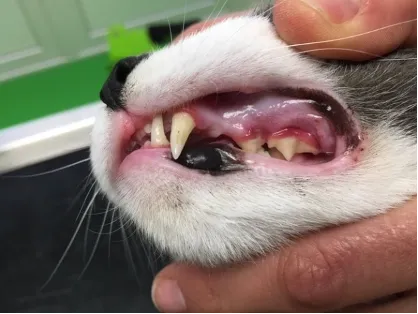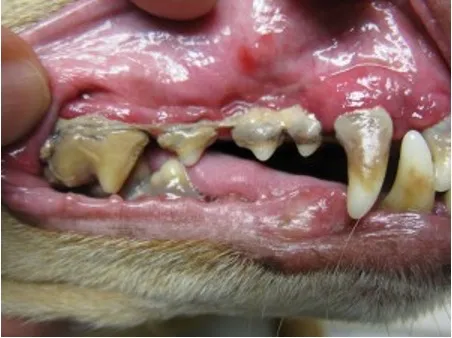Dental problems in cats and dogs
Dental problems, we see it a lot and it’s very often missed by the owners. That’s not so strange since it’s a health problem most owners are not familiar with. Problems located in the mouth are not visible and because most animals just keep eating like they always do and don’t show any signs of pain, it stays unnoticed. Therefore our advice is to do a dental check regularly.
Plaque and tartar
Dental problems almost always start with a buildup of dental plaque. Plaque is a thin layer of bacteria, food remnants, and saliva that sticks to the teeth. Just like us, plaque should ideally be removed every day. If plaque isn't removed in time, it will calcify into tartar under the influence of saliva. This creates a rough surface on teeth and molars where more plaque will stick, causing the problem to further expand. Plaque on the teeth and molars causes inflammation at the edge of the gums, known as gingivitis.
Once tartar has formed, it cannot be removed by brushing the teeth or by using special Hill’s T/D food. A dental cleaning is required, during which we remove the tartar on the teeth and under the gums with instruments.
What are the consequences of plaque and tartar
Between the tartar and the gums, food remains and bacteria can cause an infection of the gums (gingivitis). This is painful!
When untreated, the infection will expand to the bones and this will cause teeth to fall out eventually. On top of that, the bacteria involved in this infection can end up in the bloodstream and can cause infection to the liver, kidneys and heart valves.
Periodontitis (Advanced Gum Inflammation)
Gum inflammation can deepen into the surrounding jawbone. As a result, the gums detach from the teeth. In the space (the pocket) that forms between the gums and the teeth, plaque accumulates again. This plaque further exacerbates the inflammation. The fibers break due to the inflammation, and the jawbone deteriorates, making the pockets deeper. In the deepened pockets, plaque partially calcifies into tartar. This progressive inflammation, with fiber and jawbone breakdown, is called periodontitis. Periodontitis can go unnoticed for a long time. Sometimes you may notice bleeding gums or bad breath, which are signs of periodontitis. Periodontitis rarely causes pain. Only in advanced stages do symptoms such as teeth becoming loose occur. Research has shown that periodontitis occurs in approximately 12.5% of dogs on average\*. However, certain breeds exhibit a much higher prevalence of periodontitis compared to others. Breeds such as the Greyhound, Spaniels, Yorkshire Terrier, Border Terrier, Toy Poodles and Brachycephalic breeds are more prone to developing periodontitis. Therefore, it's even more crucial to start good dental care practices at a young age for these breeds.
How can you recognize dental problems
- Red gums
- Gums that blood very quickly
- Bad breath
- Brown stains on the teeth
- Drooling
- Loose teeth
- Chewing on one side while eating, or stop eating hard food
Note: Especially cats are masters in hiding pain and problems, so sometimes it’s very hard to notice any signs. This doesn’t mean that everything is okay!

What can you do yourself to prevent dental problems
If we go to the dentist or oral hygienist twice a year and don’t do anything about our teeth at home, we would also have problems with our teeth. For cats and dogs it works the same way. Besides a professional dental cleaning it’s good to take care of your pets teeth at home as well. This prevents, or at least postpones, problems.
How you can do this
- It would be best to clean the teeth daily by brushing them with a special toothbrush and paste for animals. The sooner you start this, the sooner they will get used to it. If you’re not able to brush (especially adult cats can be difficult patients to start brushing) there’s a very good alternative; Hill’s T/D dental food. This food prevents the formation of plaque and has a brushing effect while eating, because of the big size and the rough surface of the food
- Use Stomodine. This is a fluid you can apply in the mouth with an easy applicator. This fluid provides a bacteria free environment and prevents plaque. Also it will help to recover infections of the gums
- A dental check at the vets every 6 months
- If necessary, a professional dental treatment

*O’Neill DG, Mitchell CE, Humphrey J, Church DB, Brodbelt DC, Pegram C Epidemiology of periodontal disease in dogs in the UK primary-care veterinary setting. J Small Practice. 2021 Dec; 62(12):1051-1061.doi:10.1111/jsap.13405